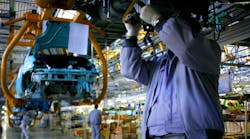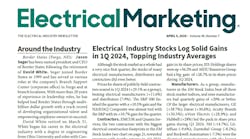Key segments of the 2020 construction market are off their recent cyclical peak in 2018, but they don’t appear to be poised to push the economy into recession next year. That was a key takeaway from the 2020 Dodge Construction Outlook held in Chicago on Oct. 30-31.
Cristian deRitis, deputy economist for Moody’s Analytics, said that although the probability of a recession increased over the past 12 months, key macroeconomic variables put the odds at approximately 20%, while the financial variables that he tracks reflect a better chance, but still less than 50/50. He said that consumers are “driving what little growth there is in the economy” right now. An economic indicator of concern is the fact that businesses are not making capital investments in their operations, he said.
Neither deRitis or Richard Branch, chief economist, Dodge Data & Analytics, believe key economic indicators point to a downturn anywhere near what the economy experienced in 2007-2009 during the Great Recession. Branch agreed with deRitis that the lack of business investment is a problem. He said the tension over trade negotiations were the “number one risk” to the economy.
“Soft data suggests that trade tensions and the uncertainty causing them are causing businesses to pull back or cancel investments,” he told the crowd of construction industry executives at the Marriott Downtown Chicago Renaissance Hotel, adding that the U.S. economy will probably slow down to approximately 2% growth by the end of the year. “We don’t see the U.S. economy entering a recession in 2020. A slowdown yes, a recession no,” he said.
Branch said contractors are not worried about finding construction jobs, but that they are having a hard time finding workers. He estimates a record 375,000 jobs are open in the construction industry right now. With electrical contractors typically employing 13% of all construction workers, that means an estimated 48,750 electrical jobs are open.
“Contractors think they have the jobs to keep them going over the next 12 months,” said Branch. “It’s finding the skilled labor. We think the lack of available labor will put a serious crimp in the economy, and not only in the contractor market.”
None of the key segments of the construction market are immune to the slowdown. Branch said single-family housing construction, a leading indicator of future market conditions, peaked in 2018 and will see mild declines in 2019 and 2020 of -3% and -5%, respectively. Although interest rates are super-low right now, he said the cost of single-family homes is outpacing what Millennials can afford in many markets. This age demographic is a huge potential customer group for entry-level single-family homes, and when they enter the market, they will have a very positive impact on the housing market.
Branch says the multi-family housing market also peaked in 2018. Although he expects declines of 11% in 2019 and -15% in 2020,this housing niche was riding along at a high level and was enjoying several of its busiest years since the Great Recession. Over the past few years, multi-family housing data has been skewed by an unprecedented explosion of activity in New York and some other metros. According to Dodge Data, through the first nine months of 2019, New York has seen $12.9 billion worth of multi-family housing construction, more than double that of Washington, DC, in second place. Los Angeles and Miami round out the top four markets for multi-family housing.
Office construction is expected to peak in 2019 after several years of steady growth. Dodge expects the dollar value of office construction to grow +6% in 2019 to $50.9 billion, as it has lagged other construction categories. Key to its recent growth has been the construction of new corporate headquarters over the past few years, including Toyota in Plano, TX, Apple in Silicon Valley, and Amazon in downtown Seattle.
Construction of new schools in the K-12 market segment has been sluggish in recent years because of struggles with public financing and declining enrollments in some market areas, but in faster-growing Sunbelt metros, this key market segment is still strong. Campus projects for colleges and universities have also been a hot market, but demographic trends driving down the number of new students are starting to have an impact.








